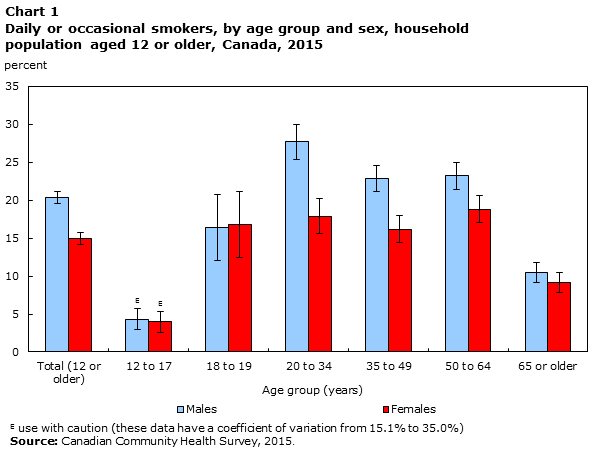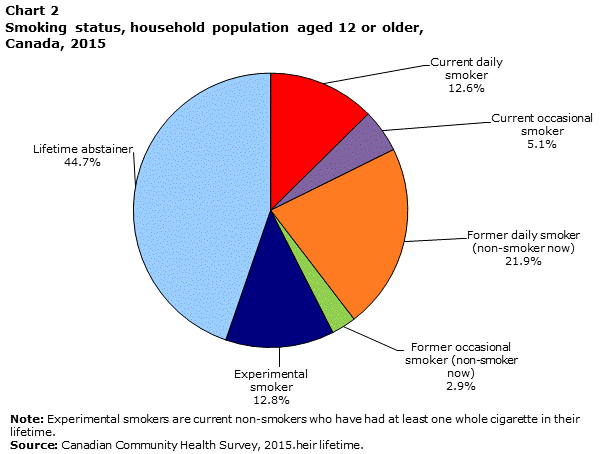Health Fact Sheets
Smoking, 2015
Archived Content
Information identified as archived is provided for reference, research or recordkeeping purposes. It is not subject to the Government of Canada Web Standards and has not been altered or updated since it was archived. Please "contact us" to request a format other than those available.
In 2015, 17.7% of Canadians aged 12 and older, roughly 5.3 million people, smoked either daily or occasionally.Note 1 Among the sexes, the proportion who smoked daily or occasionally was higher among males (20.4%) than females (15.0%).Note 2 (Chart 1)
Smoking is a risk factor for lung cancer, heart disease, stroke, chronic respiratory disease, and other conditions.Note 3 According to the World Health Organization, smoking is an important and preventable cause of death.Note 4
Across all age groups, smoking was least common among youth aged 12 to 17 (4.1%), followed by adults 65 or older (9.8%). The group with the largest proportion of smokers was males aged 20 to 34 – about one in four (27.7%) men in this age group were smokers (Chart 1).Note 5

Data table for Chart 1
| Age group (years) | Percent | Confidence Interval | |
|---|---|---|---|
| Lower 95% | Upper 95% | ||
| Males | |||
| Total (12 or older) | 20.4 | 19.6 | 21.2 |
| 12 to 17 | 4.3Note E: Use with caution | 2.9 | 5.7 |
| 18 to 19 | 16.4 | 12.0 | 20.8 |
| 20 to 34 | 27.7 | 25.4 | 30.0 |
| 35 to 49 | 22.9 | 21.2 | 24.6 |
| 50 to 64 | 23.2 | 21.4 | 24.9 |
| 65 or older | 10.5 | 9.2 | 11.8 |
| Females | |||
| Total (12 or older) | 15.0 | 14.3 | 15.8 |
| 12 to 17 | 4.0Note E: Use with caution | 2.7 | 5.2 |
| 18 to 19 | 16.8 | 12.1 | 21.4 |
| 20 to 34 | 17.9 | 16.2 | 19.6 |
| 35 to 49 | 16.2 | 14.9 | 17.6 |
| 50 to 64 | 18.8 | 17.4 | 20.2 |
| 65 or older | 9.2 | 8.2 | 10.2 |
|
E use with caution Source: Canadian Community Health Survey, 2015. |
|||
The majority of current smokers, roughly 3.8 million people, smoked cigarettes daily while the majority of non-smokers were lifetime abstainers (44.7%). Just over one in five Canadians (21.9%) were former daily smokers (Chart 2).

Data table for Chart 2
| Percent | Confidence Interval | ||
|---|---|---|---|
| Lower 95% | Upper 95% | ||
| Current daily smoker | 12.6 | 12.2 | 13.0 |
| Current occasional smoker | 5.1 | 4.7 | 5.4 |
| Former daily smoker (non-smoker now) | 21.9 | 21.4 | 22.4 |
| Former occasional smoker (non-smoker now) | 2.9 | 2.7 | 3.1 |
| Experimental smoker | 12.8 | 12.3 | 13.3 |
| Lifetime abstainer | 44.7 | 43.9 | 45.4 |
|
Note: Experimental smokers are current non-smokers who have had at least one whole cigarette in their lifetime. Source: Canadian Community Health Survey, 2015. |
|||
People typically begin smoking during their teenage yearsNote 5, so the percentage who have not started smoking by age 20 is an indicator of future smoking rates. In 2015, 57.9% of Canadians aged 20 to 24 had never smoked. In the 20 to 24 age group, the proportion for never smoking was higher for females (64.9%) than for males (51.8%).Note 5
The percentage of residents who smoked daily or occasionally was lower than the national average (17.7%) in:
- Prince Edward Island (14.9%)
- British Columbia (13.8%)
The percentage of residents who smoked daily or occasionally was higher than the national average in:
- Newfoundland and Labrador (24.4%)
- Quebec (18.6%)
- Saskatchewan (21.8%)
Residents of the other provinces reported rates that were about the same as the national average.
References
Shields, M. 2007. “Smoking bans: Influence on smoking prevalence.” Health Reports. Statistics Canada Catalogue no. 82-003. Vol. 18, no. 3. (Accessed January 17th, 2017)
Shields, M. 2005. “The journey to quitting smoking.” Health Reports. Statistics Canada Catalogue no. 82-003. Vol. 16, no. 3. (Accessed January 17th, 2017)
Shields, M. 2005. “Youth smoking.” Health Reports. Statistics Canada Catalogue no. 82-003. Vol.16, no. 3. (Accessed January 17th, 2017)
World Health Organization. 2008. “WHO Report on the Global Tobacco Epidemic, 2008.” The MPOWER Package. Geneva. (Accessed January 17th, 2017)
Jiajian, C., and W.J. Millar. 1998. “Age of smoking initiation: Implications for quitting.” Health Reports. Statistics Canada Catalogue no. 82-003. Vol. 9, no. 4. (Accessed January 11th, 2017)
Data
Additional data from the Canadian Community Health Survey are available from CANSIM 105–0508.
- Date modified:

